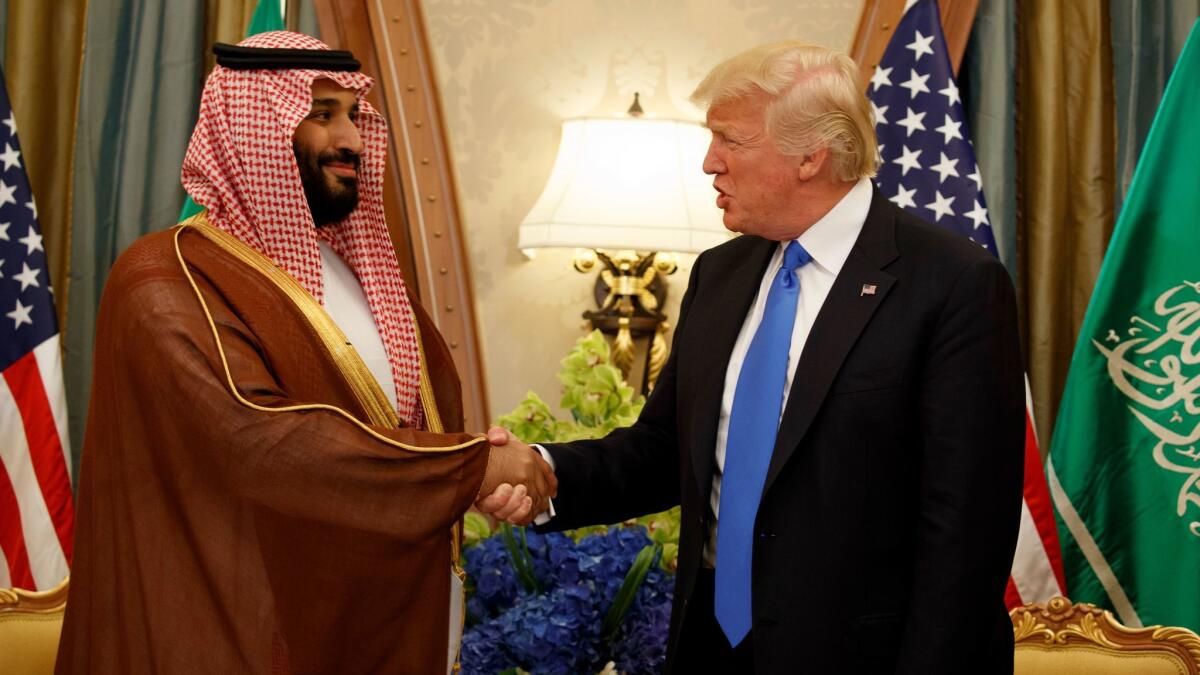Trump keeps touting jobs spurred by Saudi deals. It’s not clear they’ll ever come

- Share via
Reporting from Washington — President Trump can’t stop boasting about nearly $400 billion in military and business deals his administration made during his two-day visit to Saudi Arabia last month.
“These deals will bring many thousands of jobs to our country,” he said as he convened his first full Cabinet meeting Monday. Then he upped the tally: “In fact, will bring millions of jobs ultimately.”
But a detailed review by The Times shows that only some of the deals have produced signed contracts, others may never be realized, and the primary goal of many of the initiatives is boosting the economy of Saudi Arabia, not the United States.
The centerpiece of the agreement — a $110-billion arms deal — must contend with legal, financial and political tests before it can be realized.
As he announced the package of agreements at a news conference with Secretary of State Rex Tillerson in Riyadh last month, Saudi Foreign Minister Adel al-Jubeir valued the commercial deals as “in excess of $380 billion,” coming over a period of 10 years.
Tillerson said the deals included 23 foreign investment export licenses which would lead to $350 billion in direct investment, in addition to a $110-billion arms package. Both men said the agreements would result in “hundreds of thousands of jobs” in both nations.
“This is an indication of the confidence that the Kingdom of Saudi Arabia has in the United States’ investment climate,” Tillerson said.
The details tell a less definitive story.
The two largest commercial deals announced involve initiatives launched in partnership with a Saudi government-managed investment fund.
In one of the initiatives, backed by Japanese telecom giant SoftBank, a tech-focused “Vision Fund” would use $100 billion to buy pieces of private and public firms, focused on the so-called Internet of things, artificial intelligence, robotics and mobile communications. The fund is based on the British island of Jersey, with support from teams in London, Tokyo and Silicon Valley, and its outlays won’t be limited to U.S. companies.
The announcement appeared to follow up on one made by SoftBank CEO Masayoshi Son during a visit to Trump Tower in New York in December. At that point, he said the investment fund could create 50,000 new jobs in the U.S.
A source familiar with the fund, speaking anonymously to comment on its business plan, said that SoftBank views the United States as an attractive market, but that there is no specific geographic focus for its investments. Saudi Arabia’s role in the fund was announced in October, before Trump took office; the announcement during Trump’s visit focused on new commitments from Apple, Qualcomm and other investors.
In the other initiative, U.S.-based Blackstone signed a memorandum of understanding to launch an infrastructure fund anchored by $20 billion from Saudi Arabia’s Private Investment Fund with a goal of ultimately investing $100 billion in projects. The money would be aimed primarily, though not exclusively, at projects in the United States.
The remaining commercial deals that Tillerson and Jubeir touted appear be a mix of previously announced or updated agreements between U.S. and Saudi firms, some primarily aimed at boosting employment in Saudi Arabia.
A press release from GE, for instance, said its $15-billion package would benefit both nations, but said the plans were geared toward Saudi Vision 2030, an initiative led by Crown Prince Mohammed bin Salman that aims to spur new economic development in Saudi Arabia to counterbalance the long-term decline of oil production.
GE estimates that the new announcements could double its workforce in Saudi Arabia while adding, directly or indirectly, 20,000 jobs in the United States, mainly through additional exports.
An announcement by ExxonMobil and Saudi-based chemical producer SABIC only commits each to study the possibility of a jointly run petrochemical complex in Texas. An estimated $50 billion in deals between U.S. energy companies and Saudi Aramco include a mix of joint ventures, memoranda of understanding, and feasibility studies for projects in Saudi Arabia that could add more than 13,000 jobs there, according to the Saudi oil giant.
The White House has not produced its own itemized accounting for its $350-billion figure or an analysis of how many jobs it would create.
One document that officials allowed a reporter to briefly review in Riyadh listed 31 proposed memoranda of understanding, broken down by industry sectors with estimates of economic impact. Impact estimates, the document noted, were “supplied by Saudi sources and are not verified.” The document estimated the total impact at nearly $275 billion, with some projects undetermined.
The Trump administration’s insistence that the big-ticket defense deals will boost American jobs also appears exaggerated: Assembly of the weapons has been underway for years – even decades; the defense contractors have committed to do much of the work inside Saudi Arabia, not the U.S.; and based on past experience, some share of the proposed arms deals will never materialize.
The arms deal does, potentially, keep assembly lines running for a longer time and offer non-economic benefits to the U.S.
“The Saudi deal is huge, but it unfolds over many years and has many moving parts,” said Loren Thompson, a defense policy analyst at the Lexington Institute in Arlington, Va. “At the very least, it strengthens ties between Washington and Riyadh at a time when Saudi support remains crucial to U.S. geopolitical and energy goals.”
A senior administration official who was not authorized to speak on the record said the long-term commitments made by the Saudis — announced publicly, rather than agreed to in private -- were “unprecedented, particularly for that magnitude.” The fact that the commitments were public makes it more likely that they will ultimately be realized, the official said.
“The Saudis had been seriously considering equipment from other countries,” the official said. “It’s emblematic that you had to have confidence in the strategic relationship in order to see that through.”
But the direct jobs benefits are likely to be limited. Lockheed Martin Corp., for instance, said the final assembly of 150 S-70 Black Hawk utility helicopters that the Saudis hope to buy will be carried out inside the country. The program, part of deal potentially worth more than $28 billion, is expected to create 450 jobs in Saudi Arabia.
Raytheon Co., maker of missiles and military electronics, announced the formation of a unit called Raytheon Arabia, to focus on helping build Saudi capability to provide defense, aerospace, and security on their own.
“We fully anticipate this work will enable us to expand our business in the kingdom with new programs that will benefit both local and U.S.-based job growth,” said Corinne Kovalsky, a company spokeswoman.
General Dynamics Corp., maker of submarines and tanks, agreed to localize up to 50% of design, engineering, manufacturing, and support of armored combat vehicles inside Saudi Arabia.
Building the weapons in their own country is “something that brings national pride,” said Saeed Wahabi, a Saudi analyst based in Abu Dhabi. “Saudis are seeing other countries like Turkey and Iran building their own, having their own military-industrial complex.”
Moreover, it remains unclear whether the deals will all come to fruition, defense analysts say.
The Obama administration formally notified Congress of about $115 billion in offers of weapons, training, and military support services to Saudi Arabia, and only half of them resulted in agreements, according to William D. Hartung, director of the arms and security project at the Center for International Policy, a left-leaning think tank in Washington.
“It’s not like Trump issuing a press release about $110 billion in arms offers means U.S. companies or communities will see that kind of money any time soon,” Hartung said.
Defense deals can take five years or more between the two nations. The Saudi air force received the first of 152 F-15 fighter jets, made by Boeing Co., in December, even though the deal was initially announced to Congress in October 2010.
And a growing chorus on Capitol Hill wants the Trump administration to reconsider its commitment to arming the longtime regional ally.
Earlier this month, the Senate rejected a bipartisan measure that would have blocked a small portion of the new arms package. But the 47-53 vote on the measure, offered by Republican Sen. Rand Paul of Kentucky, reflected concerns about further entangling the U.S. in Saudi Arabia’s escalating sectarian conflict with neighboring Yemen, and ultimately Iran.
“What do you think Iran thinks when Saudi Arabia [gets] weapons? They think to themselves, if the Saudis are getting more, we need more,” Paul said ahead of the vote.
“I hope the Saudis heard this message loud and clear,” Sen. Christopher S. Murphy (D-Conn.) told reporters after the vote, noting that 20 more senators voted to block this deal than backed a similar measure last fall. Support in Congress for cutting back on arms sales is building, he said. “That day will come if the Saudis don’t change their behavior.”
For more follow @mikememoli and @wjhenn on Twitter.
Times staff writer Molly Hennessy-Fiske contributed from Riyadh.
ALSO
A tale of two princes: A king’s son and a president’s son-in-law drive Trump’s visit
Trump again criticizes Qatar as his aides scramble to head off crisis with the U.S. ally
Trump says Comey lied under oath, denies he obstructed justice or colluded with Russians
Get live updates on our Essential Washington news feed
UPDATES:
June 16, 9:41 a.m.: This article was updated to clarify the comments of a source who is familiar with the “Vision Fund.”
This article was originally published on June 15 at 1 p.m.
More to Read
Get the L.A. Times Politics newsletter
Deeply reported insights into legislation, politics and policy from Sacramento, Washington and beyond. In your inbox three times per week.
You may occasionally receive promotional content from the Los Angeles Times.












